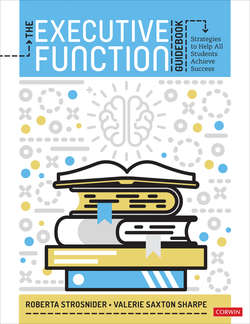Читать книгу The Executive Function Guidebook - Roberta Strosnider - Страница 15
На сайте Литреса книга снята с продажи.
What Is Universal Design for Learning (UDL)?
ОглавлениеIn the 1980s, the movement for using technology—everything from high technology, including computers, to low technology, such as highlighters—to break learning barriers and level the playing field for students with disabilities brought enlightenment to educators of all types of learners. Thus, the onset of digital texts, digital speech, and other technologies created a positive shift in instructional delivery and learning goals not only for students with disabilities, but gradually for all learners. No longer was the traditional one-size-fits-all model for instruction deemed productive in supporting learning.
The emergence of new ways to instruct students led to the development in the 1990s of Universal Design for Learning (UDL), a framework to improve and optimize teaching and learning for all people based on neuroscientific findings (Center for Applied Special Technology [CAST], 2011). UDL is founded on two premises. The first premise is that people learn via three types of networks categorized as affective, recognition, and strategic. Affective networks address the “why” of learning in terms of the student’s feelings, values, or emotions that influence learning. Recognition networks speak to the “what” of learning and how the student identifies and processes information. Finally, strategic networks attend to the “how” of learning, including how the student plans, executes, and monitors both mental and motor tasks (Meyer, Rose & Gordon, 2014, p. 51).
The second premise consists of three principles: Multiple Means of Representation, Multiple Means of Action and Expression, and Multiple Means of Engagement. Multiple Means of Representation addresses “what” the student needs to learn and how this information will be presented. Multiple Means of Action and Expression refers to “how” the student will gain this knowledge and demonstrate the knowledge. Multiple Means of Engagement employs “why” the student wants to do this. Engagement is necessary for learning that is meaningful (Meyer et al., 2014, p. 59).
The onset of the UDL model focuses on designing instruction to meet the learning needs and strengths of the student. This created a paradigm shift in instructional delivery; using this model, you teach in the manner best suited to the students’ diverse learning needs rather than teaching with the traditional one-size-fits-all approach. With that in mind, we have incorporated the UDL guidelines and added UDL considerations as an important component of our 7-Step Model. Figure 1.4 illustrates this incorporation.
FIGURE 1.4 UDL Guidelines Consideration
TABLE 1.2 Classes Without and Classes With UDL Considerations
The implementation of UDL decreases learning barriers for all students due to the emphasis on learner variability. In providing a flexible approach to instructional design and delivery, the teacher promotes learner engagement, which is essential for learning to take place. A flexible approach to demonstrating skill fluency and mastery promotes learner participation through the following: receiving purposeful content, being motivated to learn, being resourceful and knowledgeable throughout the learning process, setting appropriate goals, and implementing strategies that support the acquisition of these goals. After over two decades of using the UDL model, there is solid evidence that this instructional delivery model is best for all students, not just those students with disabilities (Meyer et al., 2014).
Executive function training provides strategies for the teacher and student to use that help compensate for the student’s areas of executive function weakness. Teaching students these strategies while incorporating UDL provides a vehicle for instructional delivery that supports the individual learning needs of each student. It is a practice that benefits all students in today’s diverse classrooms. Table 1.3 illustrates how you can teach students executive function strategies while incorporating UDL.
TABLE 1.3
Executive function skills training as described in this book involves your teaching students specific skill-building strategies incorporating metacognition that, in combination with UDL, help them with the following EF processes:
Setting goals
Self-regulating (social/emotional, inhibiting, cognitive flexibility/shifting)
Developing a game plan for learning
Attending to instruction
Organizing materials and resources
Prioritizing events and information
Initiating work within a reasonable timeframe
Managing time
Communicating their learning needs
Engaging working memory
Self-assessing progress in the mastery and the appropriate use of strategies that support executive functioning
The practice of combining executive function skills training with Universal Design for Learning and metacognition strengthens the stage for learning because the training enables students to “tune in” to instruction in the academic, communication, and social/emotional realms. Executive function training provides strategies for you and your student to use that help compensate for the student’s areas of executive function weakness.
